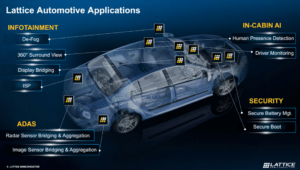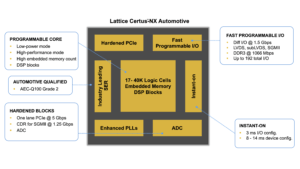
Lattice automotive applications.
Automation and connectivity have turned vehicles into data centers on wheels, with the amount of data being generated growing rapidly as new technology is introduced in the race for autonomous vehicles.
Tools and technology developed for the management of traditional data centers are now being adapted for use in automobiles.
Lattice Semiconductor has expanded its growing portfolio of automotive products with the introduction of new versions of the Lattice Certus™-NX

FPGA (field programable gate array) family. A FPGA is an integrated semiconductor that can be reprogrammed after it has been shipped and installed, unlike the equivalent discrete circuit or an Application Specific IC (ASIC). FPGA boards art typically smaller and more energy-efficient than the equivalent discrete circuit.
The new Lattice Certus™-NX FPGA is optimized for infotainment, advanced driver assistance systems (ADAS), and safety-focused applications, according to the company.
“Demand for automotive semiconductors is increasing as the ongoing trends towards automotive system electrification, autonomy, and connectivity have manufacturers looking for ways to deliver the advanced features and user experiences drivers are looking for in their next vehicle,” says Jay Aggarwal, Director of Silicon Product Marketing, Lattice Semiconductor.
Built on the Lattice Nexus™ platform, the new Certus-NX devices combine automotive-grade features with best-in-class I/O density, power efficiency, small size, reliability, instant-on performance, and support for fast PCI Express (PCIe) and Gigabit Ethernet interfaces.
“With class-leading performance and power efficiency, support for popular I/O standards in a small form factor, and high reliability, our Certus-NX general purpose FPGAs make a compelling silicon platform for the next-generation automotive applications car makers are eager to provide to their customers,” he adds. Power efficiency translates into less heat being generated by the FPGA when it is in operation – which means that it does not require additional cooling and can be fitted into smaller spaces. The Lattice FPGAs do not require a heat sink, according to the company.
“As more automotive systems go digital, modern cars have essentially become mobile datacenters,” says K. Ganesh Rao, Practice Head – FPGA Solutions, Tata Elxsi. “Automotive developers need access to secure and reliable silicon solutions with fast I/O performance to ensure mission-critical automotive systems can perform their functions instantaneously. Lattice Certus-NX FPGAs provide the reliability, performance, and feature set we need to make tomorrow’s automotive applications possible.”
The latest Certus-NX FPGAs are suitable for automotive applications like motor control, LED control in in-vehicle infotainment (IVI) systems, in-vehicle networking (IVN), and sensor data co-processing in ADAS applications.
According to Lattice, key features of Certus-NX FPGAs include:
- Low power consumption – Up to 4X lower power use than similar FPGAs, with a programmable back bias that enables user-selectable high performance or low power operating modes, depending on the needs of the application.
- Small form factor – Up to 3X smaller with up to 2X the I/O density per mm2 in comparison to similar competing FPGAs.
- Instant-on performance – Ultra-fast device configuration from SPI memory up to 12X faster than similar competing FPGAs, with individual I/Os able to configure in just 3 milliseconds, and full-device startup in only 8-14 ms, depending on device capacity.
- Robust I/O interfacing capability – Lattice’s extensive Certus-NX I/O IP library includes:
- 5 Gbps differential I/O with performance up to 70 percent higher than competing FPGAs.
- 5 Gbps PCIe, 1.5 Gbps SGMII, and 1066 Mbps DDR3.
- Automotive certification and high reliability – Certus-NX FPGAs are AEC-Q100 qualified and provide up to 100X better soft-error rate (SER) performance than similar FPGAs.
- Authentication and encryption – To protect bitstreams against unauthorized access, Certus-NX FPGAs support AES-256 encryption with ECDSA; they are currently the smallest FPGAs on the market to support ECDSA.
- Ease of use/design – Lattice Radiant® and Lattice Propel™ software tools help simplify and accelerate automotive system design.
- Certus-NX FPGAs are also supported by the Lattice mVision™ and Lattice sensAI™ solution stacks so designers can leverage the stacks’ modular hardware platforms, reference designs, neural network IP cores, and custom design services to accelerate automotive vision system design.












More Stories
Cybord warns of dangers of the stability illusion
How Modern Power Management Enhances Connected Fleet Tech
Automotive Industries interviews Bahar Sadeghi, Technical Director, Car Connectivity Consortium (CCC)